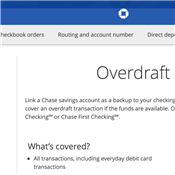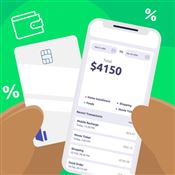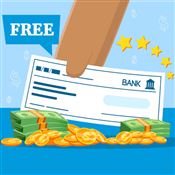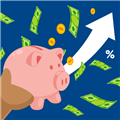Overdraft Protection Definition
Everything you need to know about overdraft protection: the official definition, how it works, different methods to avoid overdraft fees, and more.
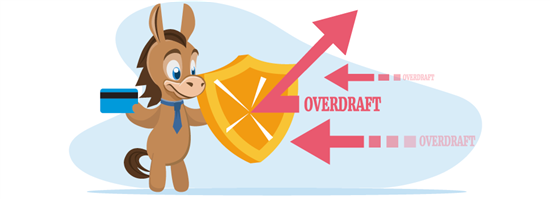 |
Imagine you're paying for groceries, but don't have enough money in your account to cover the expense. What happens?
Enter: overdraft protection. But is this feature really a blessing or a curse for consumers?
In this article, we'll review everything you need to know about overdraft protection. Get to know what it means, what protects you from predatory banks, and how to avoid overdraft fees.
Let's begin with a simple definition of the term overdraft.
Overdraft Definition
The word "draft" in financial terms refers to a written order for the payment of money from a bank account.
To "overdraft" your account means you don't have enough money to cover a purchase, but the payment goes through anyway. This is because the bank covers the remainder — resulting in a negative account balance.
Many banks today provide overdraft protection. Let's review what that means and the pros and cons of overdraft protection.
What is Overdraft Protection and How Does it Work?
Overdraft protection allows you to overdraw your account instead of getting your card declined.
This can come in handy in some cases. Say you don't have enough to cover an emergency expense. Or maybe you want to avoid the embarrassment of having your card declined.
When you overdraft your account, the bank uses their own funds to pay for the purchase of the product or service. After an overdraft occurs, you must pay the bank or credit union back for the overdraft amount, as well as any overdraft fees.
These can take the form of overdraft fees, non-sufficient funds fees (NSF), or returned check fees.
Example 1: You have $75.00 in your checking account and visit the grocery store and spend $100.00. You have overdrawn your account by $25.00 and you face a $25.00 fee. As a result your balance is now -$50.00.
Example 2: It's the 1st of the month and rent is due ($750.00). You have $800.00 in your account, but you forget your cable bill ($60.00) has not yet been cleared. When both payments clear, you have overdrawn your account by $10.00, face a $25.00 overdraft fee, and now have an account balance of -$35.00.
Is Overdraft Protection Good or Bad?
While it sounds nice in theory, many consider overdraft protection to be a predatory practice that takes advantage of low-income bank customers.
The Bad
Overdraft fees are basically an extremely expensive loan, especially considering that the overdrafted amount is typically small.
For example, if you overdraw your account by $15 and pay a $30 overdraft fee or NSF fee, this is like taking out a loan with 200% interest.
If your bank charges fees for overdrafting your account, this is certainly not a good thing. (Chase, for example, charges a hefty $34 fee for insufficient funds.)
The Good
However, as we explained above, overdraft protection can be beneficial if you absolutely need to pay for an emergency expense and don't have the funds to cover it, such as a hospital bill or car repairs.
Another benefit of overdraft protection is that it can help you avoid other fees, which may be more expensive than the overdraft fee itself. These can include late payment fees and bounced check fees for bills and other recurring payments.
As a result, overdraft protection is neither "good" nor "bad." It is just another fee to consider and attempt to avoid as you weigh your banking options.
How Do You Use Overdraft Protection?
If you opt in to overdraft protection, the feature will automatically kick in if you overdraft your account when using your debit card or checking account to make a payment. No action is required on your part to activate overdraft protection.
In the next section, we'll cover several ways in which you can avoid overdraft protection fees.
Not really. While you can spend over your credit card limit by specifically requesting over-the-limit coverage, this is rare and is not actually referred to as "overdrafting."
Overdraft Protection Fees
Since overdrawing your account is essentially loaning money from the bank with no collateral, banks charge overdraft fees to avoid having customers abuse the system. Banks also use these fees as a way to create revenue.
Overdraft protection fees vary from bank to bank. An October 2020 review of 40 common banks by Insider found that the average amount banks charge for overdrawing your account is $27.92 — with a high of $38.50.
Credit unions tend to charge slightly lower overdraft fees than banks. A CreditDonkey analysis of the largest 25 credit unions found the average overdraft fee to be $26.06 as of June 2021.
Next, we'll review how to avoid paying costly overdraft fees.
5 Ways to Avoid Overdraft Fees
If you live paycheck to paycheck, overdraft fees can create what seems like an insurmountable cycle of debt. Fortunately, there are a number of steps you can take to avoid paying costly overdraft fees. Let's review five of them.
- Pick an Account with No Overdraft Fees
Many banks — especially digital-only challenger non-banks — will allow you to overdraft your account without paying any fees.For example, with Chime's SpotMe service, customers can overdraft their account up to $200 — always with no fees. All you have to do is pay back the negative balance on your account from your savings account or linked debit or prepaid card.
Read More: Chime Review - Is It Good?
- Use a Prepaid Card
With prepaid cards, you can't overdraft your account because you are only allowed to use the pre-loaded funds you add to the card. - Opt Out of Overdraft Protection
Thanks to a November 2009 amendment to Regulation E, 12 C.F.R. Part 205, banks can only provide overdraft protection if customers authorize it.If your bank provides overdraft protection, you can opt out of this feature so that any transaction that exceeds your checking account balance is declined.
- Set Up Low-Balance Alerts
Most banks now allow you to set up low-balance alerts. These alerts notify you whenever your balance falls below a certain threshold that you choose.For example, you can receive a push notification on your phone whenever your balance falls below $25 so you know in advance not to spend any additional funds.
- Link Your Savings Account
As our last option, you can choose to link your savings to your checking account. This way, any time your checking account is overdrawn, the funds will automatically be transferred from your savings to cover the cost.This is arguably the best way to avoid fees AND embarrassment at the same time. You'll be able to cover the cost and you overdraft with your own money instead of owing the bank.
Just be sure to check out your bank's savings account transaction limits. Most banks only allow six savings account transactions per month and exceeding that amount can trigger excessive transfer fees.
What is an Overdraft Protection Loan
An overdraft protection loan works the same way as a line of credit in the event of an overdraft from your account. In most cases, there are no fees associated with an overdraft protection loan and there are no costs unless you actually use it (by overdrafting your account).
Overdraft protection loans can help you save on hefty fees resulting from an overdrawn account. Here are two examples:
| Institution | Interest Rate (APR) | Limits |
|---|---|---|
| SchoolsFirst Credit Union | 12.90% | $100–$5,000 |
| Meridia Credit Union | 17.95% | $500–$3,500 |
This type of loan is ideal for business owners who may overdraw their account frequently due to the number of checks issued to suppliers and a constantly shifting cash flow.
The Bottom Line
Overdraft protection can help you pay for emergency expenses when funds are low. However, be aware that the fees associated with overdrafting your account can quickly add up.
Best practice is to avoid overdraft fees altogether by finding the way that works best for you — for example, finding a bank that allows you to overdraw your account with no fees so you only have to pay back your negative account balance.
Write to Justin Barnard at feedback@creditdonkey.com. Follow us on Twitter and Facebook for our latest posts.
Note: This website is made possible through financial relationships with some of the products and services mentioned on this site. We may receive compensation if you shop through links in our content. You do not have to use our links, but you help support CreditDonkey if you do.
|
|
|
